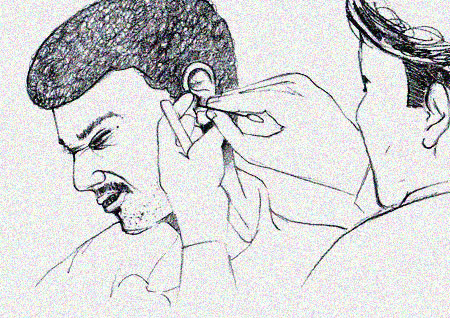They come in all shapes and sizes and are preferred targets for broody school teachers. Their appearance is believed to be telling of personality traits. They accommodate multiple accessories. Yet many of our conceptions about these organs are misplaced. We are talking about ears of course. In smaller towns of India, one still comes across professional ‘ear cleaners’. Yes, people who clean ears for a living! It must not be easy. For one, they usually do not have a shop, let alone a stall. They just hang around at curbs with bottles of colorful oils/medicines claimed to clean that ear like it was never cleaned before. And he has tools that make the dentist look like an amateur. But it is now known that ear aches are mostly due to infection and are not be taken lightly. Well, ‘cleaning’ ears is not the answer. In fact, it can do more harm than good.
Causes: A majority of ear infections are those of the middle ear, called otitis media. These commonly occur along with cold, allergies and nose blockages. However, this may not always be the case. An ear infection in itself is not contagious but common colds are. Hence, ear infections can spread indirectly.
Another cause is water remaining in the ears post a bath/swim. This can lead to fungal infections. Such infections commonly affect the periphery of the ear canal and are called otitis externa.
Incidence: Ear infections have a high prevalence and affect more than 3 percent of the general population at least once a year. However, it is more common among children.
Diagnosis: Due to co-occurrence with common cold, fever is the initial symptom; the most common presentations of an ear infection would be pain and an oozing pus-like exudate from the ear. Not only is it more common in babies, but also harder to detect as infants can’t express their condition. The commonly held belief that a baby tugging its ear is indicative of an ear infection, has till date not been backed up by any scientific data. A sure way of knowing is if the baby shows complications in balance or hearing, but it may be too late by then!
It is therefore important to visit a doctor at the first sign of cold or fever. If the patient has had a history of ear infections, this needs to be mentioned to the doctor. Diagnosis is conclusive only with an ear exam and knowing the nature of the exudate. A culture may be performed of the exudates to ascertain the causative organism yet this is usually not necessary.
Treatment: The carpet bombing approach with antibiotics is a subject of much debate. As with common cold, if the infection is viral in origin, taking antibiotics is futile. A conservative approach would be to wait for at least 3 days. If the infection does not clear by then, antibiotics are administered. Pain killers or simply a cloth dipped in warm water may be used for relief.
1st line of therapy is Amoxicillin, followed by Amoxicillin + Clavulanic acid for infections that are resistant to Amoxicillin alone. In the absence of antibiotic treatment, infections usually clear within day 5. With treatment, infections may clear a day earlier. This slight expedition in recovery has to be weighed against side effects to antibiotics that many patients develop.
An argument against a guarded approach is bacterial resistance. Wide-spread bacterial resistance to antibiotics means chances of a hardy infection that can cause damage are high. This is even more dangerous in children wherein prognosis may be bad. Recurring infections and un-healed inflammation can lead to damage of the ear drum or nerve. These can eventually triggering hearing loss to various degrees. Hence, more wide-spread prescription of antibiotics and increase in resistance is a cycle that goes on and on.
But these are decisions for your physician to take. Here is what you can do:
– Punit Pania

